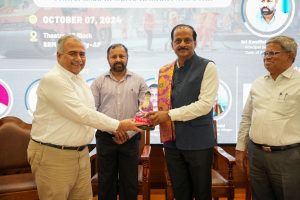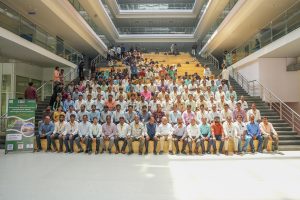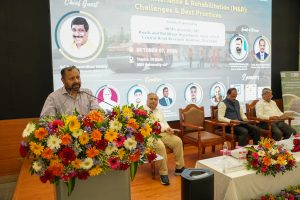Revisiting Clément Baloup’s Comics through Dr Gusain’s Research
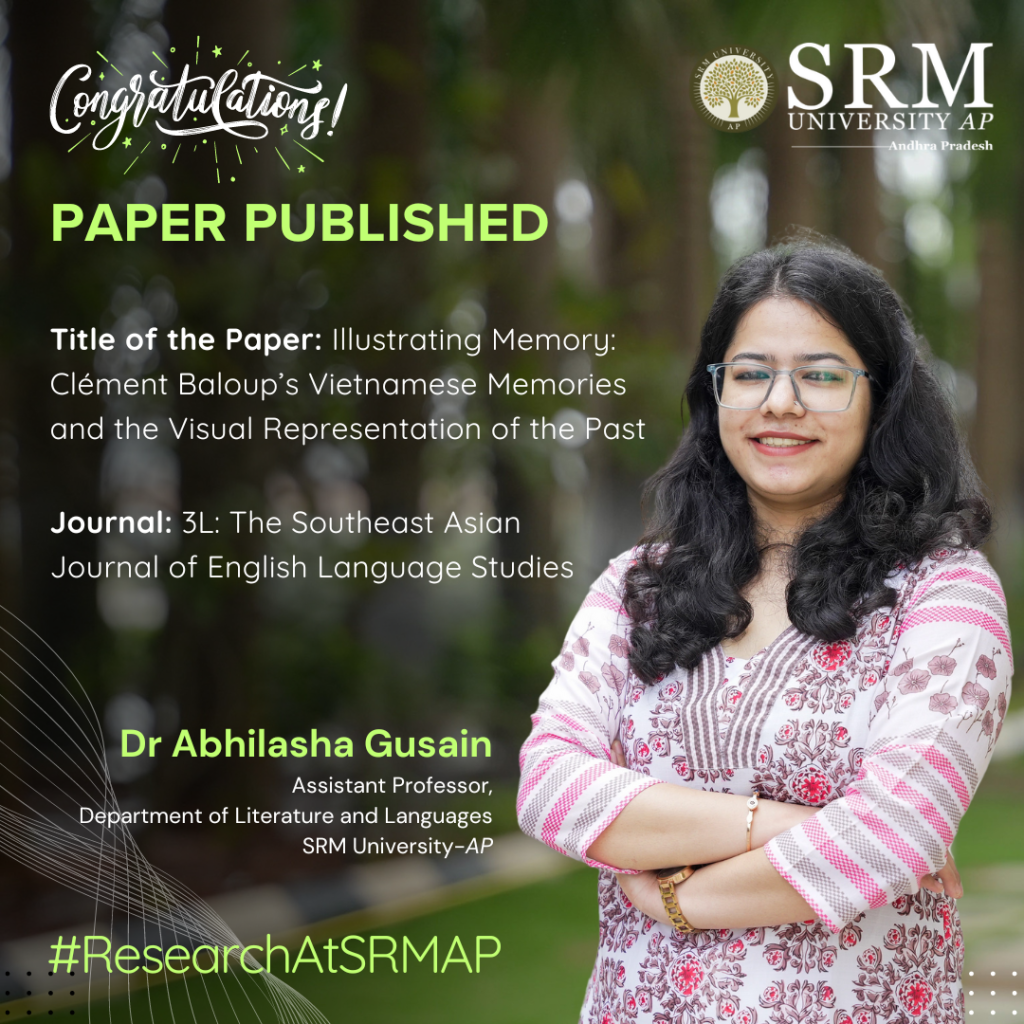
SRM University-AP is proud to announce that Dr Abhilasha Gusain, Assistant Professor in the Department of Literature and Languages has made an outstanding contribution to the academic world with her recent publication. Her research paper, “Illustrating Memory: Clément Baloup’s Vietnamese Memories and the Visual Representation of the Past,” featured in 3L: The Southeast Asian Journal of English Language Studies, a Q1-ranked journal known for its high impact in the field.
Abstract
The present study aims to highlight the role that Clément Baloup’s comics, Vietnamese Memories: Leaving Saigon (Volume 1) and Vietnamese Memories: Little Saigon (Volume 2), play in the creation of an alternate archive that validates the forgotten tales and the memories of a neglected past. These texts provide an alternate form of remembrance by materialising the past in the form of images. The two volumes present the unheard experiences of the Vietnamese diaspora that Baloup recorded during his travels to the different parts of France and the U.S. Such experiences bring to the forefront memories that are otherwise kept at the margins or suppressed by the dominant discourse. If not recorded, they will be lost forever. The counter-memory, thus, calls for a reassessment of the idea of a singular past that denies the marginalised memories. It claims representation and restoration in the cultural memory. As works of postmemory, these texts form a link between the past and the present through mediation and give memorability to unremembered accounts. The memories are illustrated, and hence, visual representation becomes important to the task of postmemory here.
Explanation of the Research:
This study emphasises the significance of visual representation in postmemory, showing how the two graphic narratives create a space for counter-memory and contribute to a reassessment of cultural memory by including marginalised experiences. Postmemory is a term used to describe how the memories of one generation are shaped by the stories and experiences of the previous generation. It often relates to events that people haven’t directly experienced, like wars or significant historical events, but feel a strong connection to through family stories, photographs, or cultural narratives. The paper illustrates how Baloup’s works serve as an alternate archival repository, creating a dynamic and inclusive cultural memory that reflects the complex, polyphonic nature of human experience; thus contributing significantly to the fields of comics studies and memory studies.
- Published in Departmental News, English Current Happenings, English news, News, Research News
B Tech Students Pave the Path for Future Entrepreneurs with Vascan Solutions
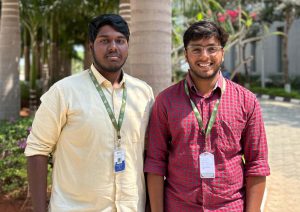 SRM University-AP is honoured to recognise the impressive accomplishments of B Tech CSE third-year students Sai Tharun Nelluru and Mahendra Kumar Velicheti, co-founders of Vascan Solutions, a startup aiming to disrupt the retail space. This is especially so when one considers that the decision to venture into entrepreneurship entails taking risks that the norm would prescribe against – seeking employment graduates.
SRM University-AP is honoured to recognise the impressive accomplishments of B Tech CSE third-year students Sai Tharun Nelluru and Mahendra Kumar Velicheti, co-founders of Vascan Solutions, a startup aiming to disrupt the retail space. This is especially so when one considers that the decision to venture into entrepreneurship entails taking risks that the norm would prescribe against – seeking employment graduates.
Vascan Solutions, as a company, is a clear Shiff economics and architecture in Context business solving real problems in the business of retailing. Understanding the pain points that exist for both shoppers and retailers, Sai Tharun and Mahendra created a mobile app intending to improve retailing activity. Shoppers can search for items, navigate inside the store accurately and use their phones to pay for items. This improves the ease of shopping for customers. On the one hand, retailers get valuable information from consumers about what they choose and how often they come. With this information, it is easy for marketers to reorganise the store improve customer service and increase sales.
The creation of Vascan Solutions is a testament to the vision and commitment of SRM AP students. However, their success story also highlights the importance of mentorship, an integral aspect of SRM AP’s entrepreneurial ecosystem. Sai Tharun and Mahendra were guided by Dr Shobin CC and Dr Randhir Singh, who provided technical expertise that helped refine their product and strategy. Additionally, Mr Siddharth Shankar Tripathy, Director of Entrepreneurship & Innovation, SRM University-AP, played a pivotal role in mentoring the co-founders, offering them the support needed to navigate the complexities of launching a startup.
SRM University-AP’s commitment to fostering entrepreneurship is evident in the success of Vascan Solutions. The university takes pride in cultivating an environment where students are encouraged to think creatively, innovate, and challenge the status quo. Sai Tharun and Mahendra’s decision to build their own business demonstrates the transformative potential of this environment. Their entrepreneurial journey serves as an inspiration not only to their peers but also to future generations of students who wish to explore non-traditional career paths and make a meaningful impact on society.
The establishment of Vascan Solutions aligns with SRM AP’s vision of empowering students to become leaders and innovators. The university strongly believes that entrepreneurship is not only a viable career option but also a path that can contribute to societal and economic development. Sai Tharun and Mahendra have proven that with determination, innovation, and the right mentorship, young entrepreneurs can turn challenges into opportunities.
Looking ahead, SRM University-AP is excited to see the continued growth of Vascan Solutions. With a solid foundation and a clear vision, the startup has the potential to scale and expand beyond the retail sector, further solidifying the impact of Sai Tharun and Mahendra’s contributions. As Vascan Solutions evolves, SRM AP remains committed to supporting entrepreneurial initiatives that empower students to become changemakers in their respective fields.
- Published in CSE NEWS, Departmental News, IDEA NEWS, News
Dr Jaidev Advances Green Chemistry with New Acetic Acid Production Technique
 In a remarkable contribution to the field of green chemistry, Dr Jaidev Kaushik, Assistant Professor in the Department of Chemistry, has published a significant research paper titled “Green Light Promoted Photoreduction of Carbonate to Acetic Acid by Zinc Ash-Derived ZCu@ZnO” in the prestigious Q1 journal, ACS Sustainable Chemistry & Engineering, with an impressive impact factor of 7.1.
In a remarkable contribution to the field of green chemistry, Dr Jaidev Kaushik, Assistant Professor in the Department of Chemistry, has published a significant research paper titled “Green Light Promoted Photoreduction of Carbonate to Acetic Acid by Zinc Ash-Derived ZCu@ZnO” in the prestigious Q1 journal, ACS Sustainable Chemistry & Engineering, with an impressive impact factor of 7.1.
Dr Kaushik’s research addresses the pressing need for sustainable methods of producing acetic acid, a widely used chemical in various industrial applications. The study explores an innovative photoreduction process that utilises green light to convert carbonate compounds into acetic acid using a novel catalyst derived from zinc ash. This approach not only showcases the potential for an eco-friendly production method but also emphasises the recycling of zinc waste, turning a byproduct into a valuable resource.

The paper highlights the efficiency of Zinc Ash-Derived ZCu@ZnO as a catalyst in the photoreduction process, demonstrating its effectiveness under green light conditions. The findings could pave the way for more sustainable practices in chemical manufacturing, aligning with global efforts to reduce carbon emissions and promote environmentally friendly technologies.
This publication underscores the commitment of SRM University – AP to fostering innovative research that addresses contemporary environmental challenges. Dr. Kaushik’s work exemplifies the university’s focus on sustainability and its aspiration to lead in the field of scientific research.
As the demand for sustainable chemical processes grows, Dr Kaushik’s research will likely inspire further investigations and developments in green chemistry, contributing to a more sustainable future.
Abstract of the Research
Mineralized carbon (carbonate) is the readily available carbon dioxide (CO2) source in acidic aqueous conditions. The photoreduction of carbonate to value-added hydrocarbons could be a novel finding performed in the presence of monochromatic visible light and waste-derived photo-active nanomaterials. In this report, we have synthesized ZnO particles from the zinc ash generated as waste in the galvanization process in the steel industry; ZnO particles were decorated with CuO nanoparticles and then further activated by reducing them to get a heterojunction photocatalyst (ZCu@ZnO). After that, ZCu@ZnO is utilized to photoreduce carbonate to acetic acid (AcOH) in a peroxy-rich solvent as a hydrogen-rich solvent under various monochromatic light sources and sunlight. Additionally, different physical and chemical parameters, such as solvent mixture, light sources, photocatalysts, time, etc., were optimized to get the maximum yield of AcOH under monochromatic light of 525 nm wavelength (Green light).
Explanation of the Research in Layperson’s Terms
This report is proposing the solution of two problem statements; first, utilization of zinc ash generated as a by-product after galvanization process; and second, cost-effective and energy efficient process for conversion of carbonates to value-added C2 hydrocarbon.
Practical Implementation and the Social Implications associated with the Research
The process adds value by converting low-value waste into high-value nanomaterials, potentially offering new revenue streams for recycling and waste management industries. It supports the principles of a circular carbon economy and green chemistry focusing on synthesis of hydrocarbons from carbonates.
Collaboration
Dr Sumit Kumar Sonkar (MNIT Jaipur, India)
Future Research Plans
1. The adsorption/photodegradation-assisted quick and efficient removal of next generation advanced pollutants such as microplastic, pesticides, pharmaceutical waste, etc. by hydrophobic carbon aerogel and their doped and functionalized versions.
2. Utilizing waste derived heterogeneous catalysts in organic transformation reactions.
3. Selective sensing of toxic metal ions/biomarkers/biomolecules using fluorescent nanomaterials.
4. Upcycling of carbonates/CO2 via photo/thermal assisted catalyzed reactions to get C1 and C2 hydrocarbons (green fuel).
- Published in Chemistry-news, Departmental News, News, Research News
From Lab to Land: One-Day Workshop Hosted on Road Maintenance & Rehabilitation (M&R)
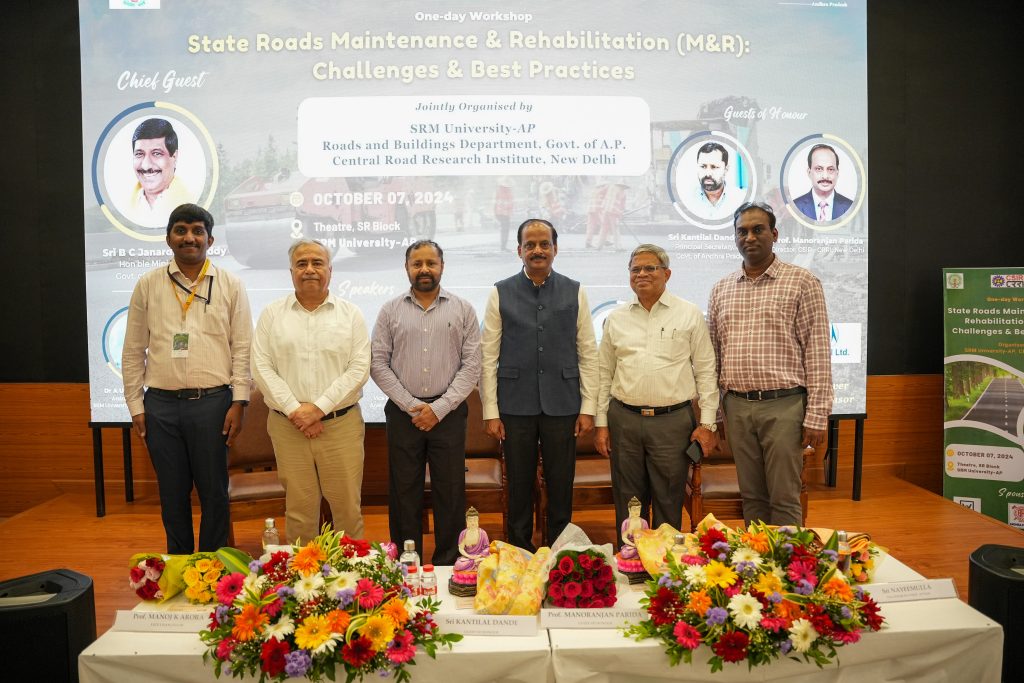
“Road is the index of a developed society” commented Sri Kantilal Dande IAS, Guest of Honour for the one-day workshop.
SRM University-AP, in association with the Andhra Pradesh Roads and Buildings (R&B) department and the Council of Scientific and Industrial Research-Central Road Research Institute (CSIR-CRRI), hosted a one-day workshop on exploring the Challenges and Best Practices for State Roads Maintenance and Rehabilitation (M&R). The ceremonious event welcomed the Honourable Minister of Roads & Buildings (R&B), Government of Andhra Pradesh, Sri B C Janardhan Reddy, as the Chief Guest along with Sri Kantilal Dande IAS, Principal Secretary, (R&B), Government of Andhra Pradesh and Prof. Manoranjan Parida, Director of CSIR-CRRI as the Guests of Honour. Distinguished dignitaries from the Government of Andhra Pradesh, the R&B Department, industries, universities, and research institutes participated in the workshop to address the critical challenges associated with the maintenance and rehabilitation of state roads.
In his virtual address to the participants, Honourable Minister Sri B C Janardhan Reddy explained that the Government had received proposals of Rs. 290 crores to convert 1393 damaged roads, covering 7071 kilometres, into pothole-free roads across the state. He said that with the latest technology and technical support from SRM University-AP, a complete restoration of the road network would be possible.
The event facilitated a constructive platform that assembled policymakers, academicians, researchers and young minds from various sectors to discuss the pressing challenges faced in the maintenance and rehabilitation of roads and exploring cost-effective and sustainable methods to achieve the same. “To tackle the key factors leading to road damage and rehabilitation, we require technical support and cutting-edge research from reputed institutes like CSIR-CRRI and new-age universities like SRM University-AP”, stated Guest of Honour Sri Kantilal Dande IAS.
Prof. Manoranjan Parida, Director of CSIR-CRRI, delivered a keynote session elucidating the immense significance of technology on road development. “A methodical approach to Road Asset Management is pivotal to ensure successful road maintenance and rehabilitation in the state of Andhra Pradesh. Sustainable technologies such as recycling technology can be utilised for rehabilitation projects, which will be cost-effective and economical”, advised Prof. Parida.
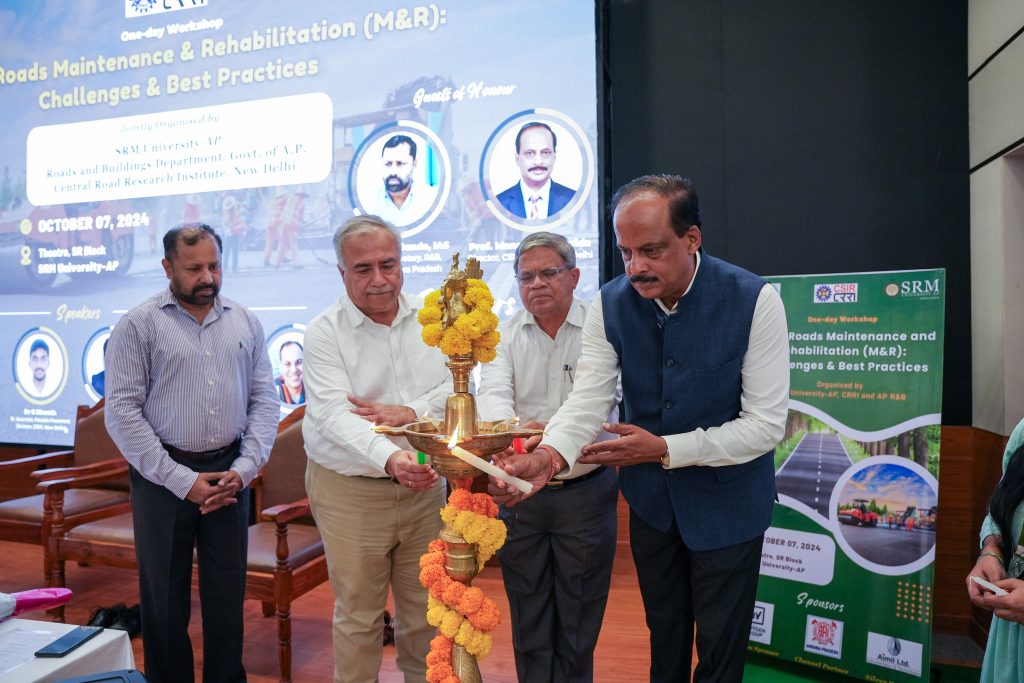
The workshop also encompassed insightful sessions on leading issues featuring esteemed speakers including Mr Nayeemulla, Engineer-in-Chief, R&B Department, Government of AP; Dr G Bharath, Sr. Scientist, Flexible Pavement Division, CRRI, New Delhi; Dr P S Prasad, Chief Scientist, Geotechnical Engg. Division, CRRI; and many more. A panel discussion on the way forward for AP State Roads M&R moderated by Mr Sitaramanjaneyulu, Visiting Professor of SRM University-AP & Former Chief Scientist, CRRI, was a highlight of the workshop.
Vice Chancellor of SRM University-AP, Prof. Manoj K Arora, praised the assemblage of government, industry, academia, research and the builders’ association at the workshop for a consulted approach towards the development of state roads. Dr Uma Maheswar, the organising secretary from SRM University-AP, stated that “Maintenance and rehabilitation of roads are key for any kind of success and development. In the next 5 to 10 years, SRM University-AP, the Government of AP and the industry will foster an ecosystem to rehabilitate the damaged roads through sustainable methods.”
The one-day workshop was a grand success in identifying a roadmap for sustainable programs tailored for AP state roads and formatting potential solutions for the challenges. The event also witnessed the presence of Mr Venkateswara Rao, Former President of the Builders’ Association of India AP Chapter, Mr Nagamalleswara Rao, President of Builders’ Association of India AP Chapter, Dr R Premkumar, Registrar of SRM University-AP, Dr Raviteja KVNS, HOD, Department of Civil Engineering, SRM University-AP, participants from neighbouring universities, industry professionals and faculty and students of SRM University-AP.
- Published in CIVIL NEWS, Departmental News, News


